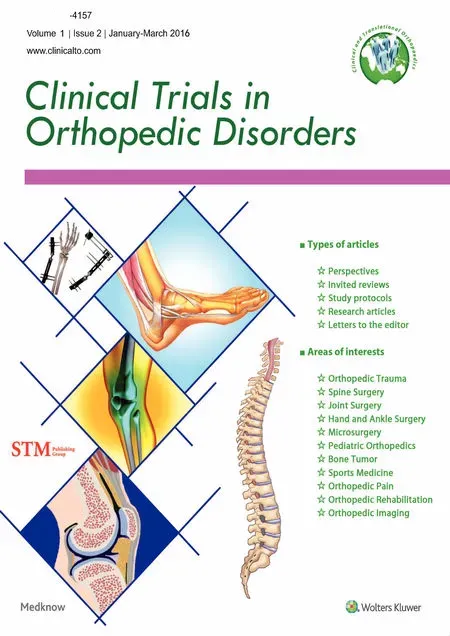Polymerase chain reaction for diagnosis of isolated tuberculosis of the wrist joint
Prakash Jyoti*, Kumar Neeraj, Kumar Dhirendra
Department of Orthopaedic Surgery, Trauma Centre, BHU, Varanasi, India
A healthy 43-year-old female patient presented to our clinic with chief complaint of pain, morning stiffness and mild swelling in right wrist joint 6 months ago. She had no history of any constitutional symptom, weight loss or involvement of other joints. She had a past history of pulmonary tuberculosis for 10 years and had undergone a full course of directly-observed treatment short course(DOTS). On examination, her right wrist joint was painful, indurated with mild cellulitic changes of the skin. She was very disinclined to actively move her affected part,and even passive movement of the joint was impossible because of pain. No obvious peripheral lymphadenopathy was noted. Vital parameters were within normal limit. All routine investigations were done. Complete blood count,random blood sugar, serum uric acid, blood urea, serum creatinine, liver function test, viral markers were all within normal range but erythrocyte sedimentation rate (45 mm at the end of first hour) and C-reactive protein level (16 mg/L) were raised. Her anti-streptolysin Otitre was also raised but rheumatoid factor was negative. Her X-ray findings of the wrist joint in either anteroposterior or lateral view reflected no significant abnormality. Also her chest X-ray findings were within normal limit. As no marked abnormality was detected on her wrist X-ray, magnetic resonance imaging was planned for further evaluation and showed a generalised osteoporosis and synovial thickening. Given our patient’s past history and India’s status as an endemic area for tuberculosis, our index of suspicion for tuberculosis of the wrist joint was high. However, routine microbiological testing with Ziehl Neelsen staining for the presence of acid fast bacteria was negative. Based on clinical and biochemical findings, we diagnosed this case as inflammatory arthritis (Desikan et al., 2016) and the patient was advised anti-inflammatory (etoricoxib tablets 60 mg twice daily) and anti-rheumatic drugs (methotrexate 15 mg weekly along with salfasalazine 500 mg twice daily and chloroquine 200 mg twice daily). Follow-up was done after 30 days.
The patient revisited our clinic after 30 days without any significant improvement in her symptoms, so again a thorough re-examination was done and battery of test was advised in form of anti-cyclic citrullinated peptide antibody (anti-CCP antibody), human leukocyte antigen B27, anti-ds DNA antibody, anti-nuclear antibody. Anti-CCP antibody titre was 46 EU/mL (negative < 20 EU/mL).Human leukocyte antigen B27, anti-nuclear antibody and anti-ds DNA antibody were negative. As anti-CCP antibody titre was raised in early stage of rheumatic arthritis and tubercular arthritis likewise, we planned to investigate the lineage of tubercular arthritis (Kakaumanu et al., 2008).Hence synovial tissue biopsy was taken for histological examination. Pathological report emphasised on the presence of lymphocyte predominant tissue but the presence of granuloma was doubtful. A senior microbiologist was consulted and advised regarding adoption of highly sensitive and specific test for Mycobacterium tuberculosis. We planned for nested PCR from serum. Blood samples was collected under strict aseptic precautions and subjected to nested PCR after DNA extraction. DNA was extracted from the specimens following the methods described by Sambrook and Russel (2000). Targeted gene was heat shock protein gene of Mycobacterium tuberculosis. The final amplification products were analyzed on 2% agarose gel stained with ethidium bromide under UV light. Out of the gloom sample came out to be positive for Mycobacterium tuberculosis (Figure 1).

Figure 1: Amplification of heat shock protein gene specific sequences of serum Mycobacterium tuberculosis (sample No. 4).
The patient was advised anti-tubercular drugs (DOTS regimen extended category I) and serial follow-up was made. The patient had improvement of pain after 3 weeks of anti-tubercular treatment. Physiotherapy consultation was made to improve the range of motion but unfortunately no active range of motion could be achieved. This experience led us to conclude that even a negative result on conventional staining for acid fast bacilli does not rule out the diagnosis of tuberculosis. Thus in case clinical suspicion is high, a more sensitive and specific test must be considered.However, the limitation created by their availability and costs has some impacts on the popularization of such tests.Furthermore, we conclude that a successful complete course of anti-tubercular therapy never gives the guarantee that there is no recurrence and no possibility of extra pulmonary tuberculosis, though the incidence of this osteoarticular tuberculosis is low (10%) (Kakaumanu et al., 2008).
Desikan P, Verma R, Tiwari K, Panwalkar N (2016) Acute monoarthritis of the wrist joint: tuberculosis or not? J Wrist Surg 5:77-79.
Kakaumanu P, Yamagata H, Sobel ES, Reeves WH, Chan EK, Satoh M (2008) Patients with pulmonary tuberculosis are frequently positive for anti-cyclic citrullinated peptide antibodies, but their sera also react with unmodified arginine-containing peptide. Arthritis Rheum 58:1576-1581.
Sambrook J, Russel D (2000) Molecular Cloning: A Laboratory Manual, 3rdEdition. New York, USA: Cold Spring Harbor Laboratory Press.
 Clinical Trials in Orthopedic Disorder2016年2期
Clinical Trials in Orthopedic Disorder2016年2期
- Clinical Trials in Orthopedic Disorder的其它文章
- Lateral dislocation of the elbow: a report of two cases and literature review
- Isometric muscle strength as a predictor of one repetition maximum in healthy adult females: a crossover trial
- Consistency of microbiological and pathological tests between infected bone and surrounding deep soft tissues in diabetic foot osteomyelitis: study protocol for a singlecenter, self-controlled, open-label trial
- Minimally invasive closed reduction and internal fixation with fully threaded headless cannulated compression screws for repair of distal radius fracture: study protocol for a randomized controlled trial
- Minimally invasive treatment of proximal humerus fractures with locking compression plate improves shoulder function in older patients: study protocol for a prospective randomized controlled trial
- Treatment of intertrochanteric femoral fracture with proximal femoral medial sustainable intramedullary nails: study protocol for a randomized controlled trial
